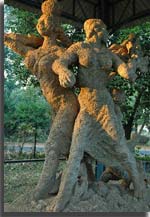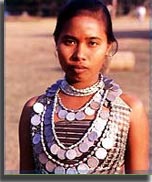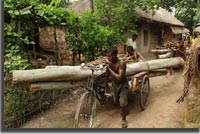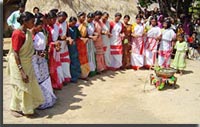History
The third largest tribes of India are the Santhal Tribe. This tribe habitation is mainly in the states of West Bengal, Bihar, Odisha, Jharkhand and Assam. They belong to the Pre -Aryan period and were the great fighters during the British regime in India. A bantam bunch comprising of the Santhals can also be traced back to Bangladesh. Santhals were brave and courgeous people who wagged war against the permanent settlement of Lord Cornwallis in 1855.

The scientists have conjectured that the individuals of the Santhal in Jharkhand had the Proto Australoids as their ancestors and these so-called Proto Australoids had embarked upon a journey towards the eastern frontier of India and eventually settled there. Many call them as "the tribes at extreme".
Place /Location (then and now) |
West Bengal , Odisha, Bihar, Jharkhand and Assam |
Population |
49000 |
Languages spoken |
Hindi, Santhali |
Religion/God |
Sarna, Sari Dhorom |
Culture

Santhals follow the Sarna religion. Their God and Goddess are Marangburu, Jaheraera, and Manjhi. The most amazing fact about Santhal is that they pay respect to the ghosts and spirits like Kal Sing, Lakchera, and Beudarang etc. Santhals have village priests known as the Naiki and shaman Ujha. In this community animal sacrifices to the Gods is common to appease the Gods and Goddesses.
Occupation

They possess unique skills in making the musical equipments, mats and baskets out of the plants.
The talent of Santhal Tribe is safely passed on from one generation to the other.
Language
Santhals speak Santhali, which belongs to the Austro- Asiatic language family. Santhals have their script called Olchiki, which was developed by Dr Raghunath Murmu in 1925. They are generally bilingual. Apart from Santhali they also speak Bengali, Oriya and Hindi. The members of the Santhal tribe have accepted the dialect Santhali as their mother-tongue. This language has also been derived from the Austro-Asiatic group of languages and has a lot of features common with the languages like Vietnamese and Khmer like most of the lingos used by the tribes. The alphabet used by the Santhali language is known as Ol Chiki. A strange feature of this alphabet is that it does not possess any similitude with the Indic or the Devanagiri scripts. Another specititley of the Santhali language is that they possess three extra vowels along with six regular ones.
People
Santhals have long head and flat nose. Their complexion varies from dark brown to black in colour. Santhals usually have curly hair.
Festivals

It is the tradition among the Santhals to grow the Karam tree outside their house after the purification process. Other festivals of the Santhal community include Maghe, Baba Bonga, Sahrai, Ero, Asaria and Namah. They also celebrate hunting festival called Disum sendra on the eve of Baishakhi Purnima.
Judicial System
The judiciary system is well organised in traditional manner. It manages and gets solution to the problem inside the community. They make every effort to solve it among themselves within in the society. The Santhal Tribe head is called as Manjhi Hadam. He is considered as the chief of the judicial, executive and other function of society. Manjhi is helped by various others like Jagmangjhi, Jagparanik, Naike and Gudit who work in the other fields in diverse areas.


